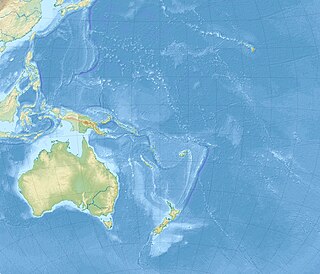
Lefaga is a village district on the south west coast of the island of Upolu in Samoa. The American movie Return to Paradise (1953), starring Gary Cooper was filmed at Matautu village in Lefaga. [1] The 50th anniversary celebrations of the making of the movie took place in Lefaga in November 2003.

Upolu is an island in Samoa, formed by a massive basaltic shield volcano which rises from the seafloor of the western Pacific Ocean. The island is 75 kilometres long and 1,125 square kilometres in area, making it the second largest of the Samoan Islands geographically. With approximately 145,000 people, it is by far the most populated of the Samoan Islands. Upolu is situated to the southeast of Savai'i, the "big island". Apia, the capital, is in the middle of the north coast, with Faleolo International Airport at the western end of the island. The island has not had any historically recorded eruptions, although three lava flows date back only a few hundred to a few thousand years.

Samoa, officially the Independent State ofSamoa and, until 4 July 1997, known as Western Samoa, is a country consisting of two main islands, Savai'i and Upolu, and four smaller islands. The capital city is Apia. The Lapita people discovered and settled the Samoan Islands around 3,500 years ago. They developed a unique Samoan language and Samoan cultural identity.

Return to Paradise is a Technicolor South Seas drama film released by United Artists in 1953. The film was directed by Mark Robson and starred Gary Cooper, Barry Jones and Roberta Haynes. It was based on a short story, "Mr. Morgan", by James Michener in his short story collection Return to Paradise, his sequel to Tales of the South Pacific. It was filmed on location in Matautu, Western Samoa.
A number of villages and districts in Samoa are called 'Matautu.'
There are seven sub-villages, pito nu'u in Lefaga;
Safa'atoa is a village on the island of Upolu in Samoa. It is situated on the south west side of the island. Safa'atoa is in the electoral constituency of Lefaga & Falese'ela which forms part of the larger political district A'ana.
Falese'ela is a village on the southwest coast of Upolu island in Samoa. It is in the district of A'ana.
Sāvaia is a village on the island of Upolu in Samoa. It is situated on the south west coast of the island in the political district of A'ana.
Lefaga was one of the areas hit by the 2009 Samoa earthquake and tsunami with fatalities and extensive damage. [2]

The 2009 Samoa earthquake and tsunami took place on 29 September 2009 in the southern Pacific Ocean adjacent to the Kermadec-Tonga subduction zone. The submarine earthquake occurred in an extensional environment and had a moment magnitude of 8.1 and a maximum Mercalli intensity of VI (Strong). It was the largest earthquake of 2009.








